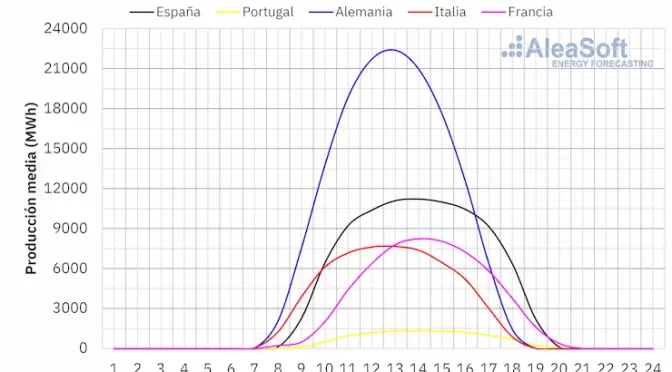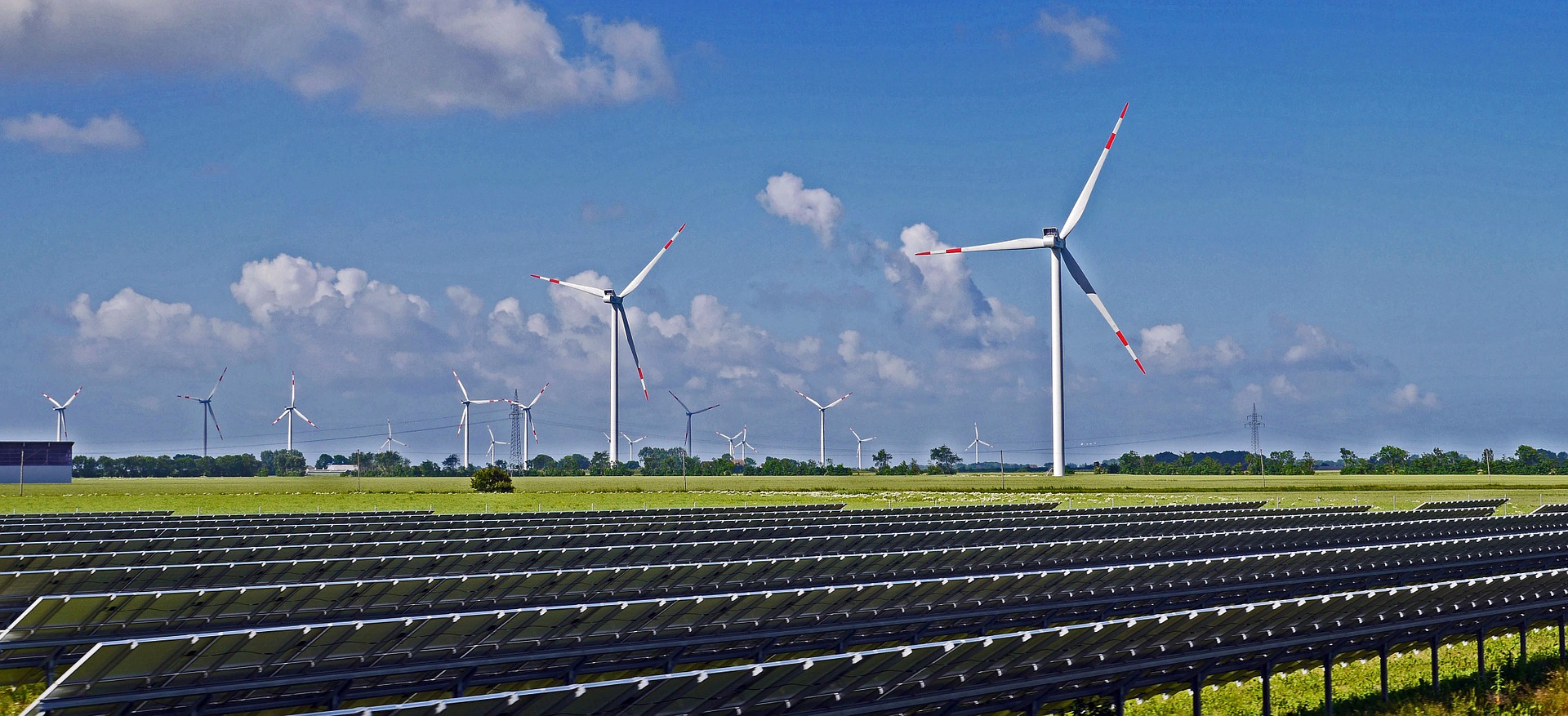In the second week of September, prices fell in the main European electricity markets. Wind and photovoltaic energy production increased in most markets, registering records for any September in Italy, Spain and France. Electricity demand fell in almost all markets, helped by cooler temperatures. Gas and CO2 futures declined, reaching the lowest prices since late July. Brent futures also fell to values not seen since December 2021.
Solar photovoltaic, solar thermal and wind energy production
In the week of September 9, solar energy production increased compared to the previous week in the French, Italian and Spanish markets. The French market registered the largest increase, 32%. In Italy it rose by 5.0% and in Spain, where it includes solar photovoltaic energy and solar thermal energy, it increased by 1.3%. In contrast, the German and Portuguese markets registered decreases in solar energy generation, 36% and 4.3%, respectively. The Spanish market registered increases for the second consecutive week, while the German market also registered declines for the second week in a row. During the second week of September, the Spanish, Italian and French markets registered historical production records for any September. On Monday, September 9, the Spanish market reached the highest daily solar photovoltaic energy production for any September, 176 GWh. The Italian market had its highest daily photovoltaic energy production for any September, 104 GWh, on the 10th and the French market on Sunday the 15th, with 107 GWh.
In the third week of September, AleaSoft Energy Forecasting’s solar energy production forecasts indicate that generation will increase in Germany. On the other hand, it will decrease in Italy and Spain.
Source: Prepared by AleaSoft Energy Forecasting using data from ENTSO-E, RTE, REN, Red Eléctrica and TERNA.
Source: Prepared by AleaSoft Energy Forecasting using data from ENTSO-E, RTE, REN, Red Eléctrica and TERNA.
In the week of September 9, wind energy production increased across the board in the main European markets compared to the previous week. The Italian market registered an increase of 286%, reaching almost three times what was generated during the previous week. The French, German and Spanish markets had increases of 88%, 47% and 40%, respectively. The Portuguese market registered the smallest increase, 7.8%.
On Friday the 13th, the Italian market reached a historical wind energy production record for any September, with a generation of 165 GWh.
In the week of September 16, according to AleaSoft Energy Forecasting’s wind energy production forecasts, the generation with this technology will fall in Italy, the Iberian Peninsula and France, while it will rise in the German market.
Source: Prepared by AleaSoft Energy Forecasting using data from ENTSO-E, RTE, REN, Red Eléctrica and TERNA.
Electricity demand
In the second week of September, electricity demand decreased in most major European electricity markets compared to the previous week. The Italian market registered the largest decline, 9.7%, while the Dutch and British markets registered decreases of 6.6% and 6.1%, respectively. The Spanish, German, Belgian and French markets registered declines ranging from 4.5% in the Spanish market to 0.3% in the French market. For the second consecutive week, the Italian, Spanish and French markets repeated the downward trend. On the other hand, the Portuguese market was the exception to the declines. In this market, demand increased by 2.0% compared to the previous week.
During the week of September 9, average temperatures fell in most analyzed markets. Germany, the Netherlands and Belgium registered the largest decreases in average temperatures, 9.3 °C, 7.9 °C and 6.1 °C, respectively. In Spain, Great Britain, Italy and France, decreases in average temperatures ranged from 1.1 °C in Spain to 4.8 °C in France. The exception was Portugal, which registered a 0.4 °C increase in average temperatures.
According to AleaSoft Energy Forecasting’s demand forecasts for the week of September 16, demand will continue to decline in the markets of Spain, Italy, Portugal, France and Germany. In contrast, demand will increase in the markets of the Netherlands, Great Britain and Belgium.
Source: Prepared by AleaSoft Energy Forecasting using data from ENTSO-E, RTE, REN, Red Eléctrica, TERNA, National Grid and ELIA.
European electricity markets
In the second week of September, average prices in the main European electricity markets decreased compared to the previous week. The EPEX SPOT market of the Netherlands registered the smallest percentage price decline, 16%. In contrast, the EPEX SPOT market of France registered the largest percentage price drop, 38%. In the other markets analyzed at AleaSoft Energy Forecasting, prices fell between 19% in the EPEX SPOT market of Germany and 36% in the Nord Pool market of the Nordic countries.
In the second week of September, weekly averages were below €80/MWh in most analyzed European electricity markets. The exceptions were the N2EX market of the United Kingdom and the IPEX market of Italy, with averages of €81.28/MWh and €107.91/MWh, respectively. The Nordic market registered the lowest weekly average, €13.55/MWh. In the other analyzed markets, prices ranged from €51.37/MWh in the French market to €79.85/MWh in the Dutch market.
Regarding hourly prices, most analyzed markets registered negative prices in the second week of September. The exceptions were the Italian market and the MIBEL market of Portugal. In the British market and the Nordic market, there were negative hourly prices on September 10. In addition to that day, the Belgian market registered negative prices on September 11 and 15, while the German and Dutch markets registered negative prices on September 14 and 15. On Sunday, September 15, the Spanish and French markets also reached negative hourly prices. The Dutch market registered the lowest hourly price of the second week of September, ?€1.83/MWh, on Tuesday, September 10, from 15:00 to 16:00. In contrast, the German market reached the highest hourly price of the second week of September, €300.01/MWh, on September 12, from 19:00 to 20:00.
During the week of September 9, the decrease in the weekly average price of gas and CO2 emission allowances, the increase in wind energy production, as well as the decrease in demand and the increase in solar energy production in most markets, contributed to the fall in European electricity market prices.
AleaSoft Energy Forecasting’s price forecasts indicate that, in the third week of September, prices will continue to fall in most analyzed European electricity markets. However, prices might increase in the Italian market, where wind and solar energy production will decrease significantly. The British and Dutch markets might also register price increases, influenced by the recovery in demand in these markets.
Source: Prepared by AleaSoft Energy Forecasting using data from OMIE, EPEX SPOT, Nord Pool and GME.
Brent, fuels and CO2
In the second week of September, settlement prices of Brent oil futures for the Front?Month in the ICE market, after registering a slight increase on Monday compared to the last session of the previous week, fell by 3.7% on Tuesday. As a result, on Tuesday, September 10, these futures registered their weekly minimum settlement price, $69.19/bbl. According to data analyzed at AleaSoft Energy Forecasting, this price was the lowest since December 2, 2021. In contrast, in the last three sessions of the week, prices remained above $70/bbl. On Thursday, September 12, these futures reached their weekly maximum settlement price, $71.97/bbl. On Friday, September 13, the settlement price dropped to $71.61/bbl, but it was still 0.8% higher than the previous Friday.
In the second week of September, the downward revision of OPEC’s demand forecasts led to the low price on Tuesday, September 10. The International Energy Agency also revised down its demand growth forecasts. However, the effects of Hurricane Francine on US supply and supply disruptions in Libya contributed to the price recovery in the last sessions of the second week of September.
As for TTF gas futures in the ICE market for the Front?Month, on Monday, September 9, they reached their weekly maximum settlement price, €37.33/MWh. In contrast, on Thursday, September 12, these futures registered their weekly minimum settlement price, €35.19/MWh. According to data analyzed at AleaSoft Energy Forecasting, this price was the lowest since July 31. On Friday, September 13, the settlement price increased to €35.65/MWh. This price was still 2.3% lower than the previous Friday.
On Monday, September 9, TTF gas futures reached their weekly maximum settlement price influenced by forecasts of cold temperatures and reduced supply from Norway. At the beginning of the second week of September, fears about the effects of Hurricane Francine on US liquefied natural gas exports also exerted an upward influence on prices. However, high European reserve levels and abundant supply helped to keep settlement prices below €38/MWh in the second week of September.
Regarding settlement prices of CO2 emission allowance futures in the EEX market for the reference contract of December 2024, on Monday, September 9, they registered their weekly maximum settlement price, €66.52/t. On the other hand, on Tuesday, September 10, they reached their weekly minimum settlement price, €64.92/t. According to data analyzed at AleaSoft Energy Forecasting, this price was the lowest since July 23. On September 11, the settlement price increased by 2.3% from the previous day. In the last two sessions of the second week of September, prices fell again. On Friday, September 13, the settlement price was €64.99/t, 2.3% lower than the previous Friday.
Source: Prepared by AleaSoft Energy Forecasting using data from ICE and EEX.
AleaSoft Energy Forecasting’s analysis on the prospects for energy markets in Europe, energy storage and self?consumption
This Thursday, September 19, AleaSoft Energy Forecasting and AleaGreen will hold the 47th webinar in their monthly webinar series. The webinar will analyze the evolution and prospects of European energy markets, energy storage, especially batteries and green hydrogen, as well as the current situation and prospects for self?consumption. In addition, there will also be an explanation of Aleasoft services for energy retailers. Xavier Cugat, Product Director at Pylontech, and Francisco Valverde, independent professional for the development of renewable energies, will participate in the analysis table of the webinar in Spanish.










